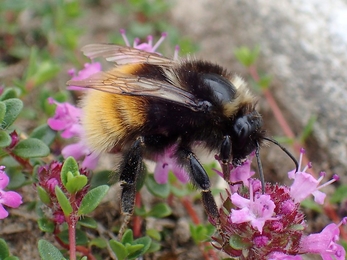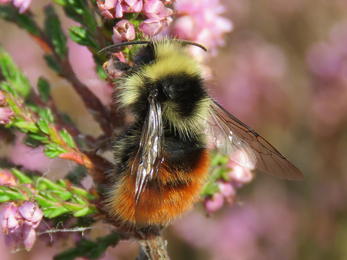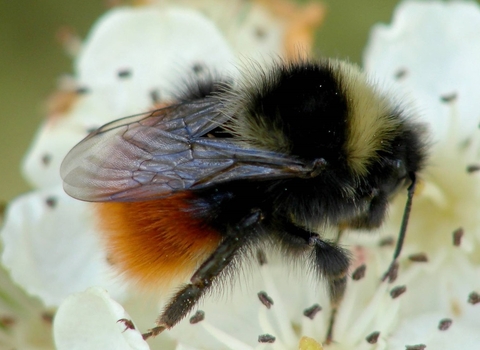Combined records between 1990 and 2020 from David Williams, the Bumblebees on the Mynd project, and various datasets displayed on the National Biodiversity Network Atlas show the Bilberry bumblebee is present on the Long Mynd and the Stiperstones.
In this area it is associated with dwarf shrub heath (65% of records) containing bilberry (Vaccinium myrtillus) and heathers (Calluna vulgaris and Erica spp.) with an optimal altitude zone of 390-500m (Andrew Perry, Stepping Stones Species Analysis 2021). This analysis also shows 91% of records are within 300m of heathland, highlighting the importance of having a continuation of nectar sources in the early spring and between spring flowering of the bilberry and late summer flowering of the heathers. Other frequently used nectar sources include willow (Salix spp.) and common gorse (Ulex europaeus) followed by marsh thistle (Cirsium palustre) and bramble (Rubus fruticosus) (studies by David Williams on the Long Mynd)
The Bumblebees on the Mynd project set up BeeWalk survey transects (a Bumblebee Conservation Trust, BBCT, monitoring scheme) in 2021 on two flowering meadows adjacent to the Long Mynd. These transects will provide long-term data collection for analysis, but the raw data for 2021 produced 18 individual records of the Bilberry Bumblebee foraging in meadows. The flowers visited included bird’s-foot trefoil (Lotus corniculatus), red and white clover (Trifolium pratense & T. repens), lesser trefoil (Trifolium dubium), yellow rattle (Rhinanthus minor), common cat’s-ear (Hypochaeris radicata) and thistles. With sufficient volunteers we plan to continue these two meadow transects with the addition of 4 heath transects in 2022.
Worldwide, bumblebee species are centred on the North Temperate Zone, where it is cool enough for bumblebees to fly without overheating. BBCT classify the Bilberry bumblebee as a ‘less common species’ in Britain because it tends to be more localised, having a limited distribution across the UK but may be quite plentiful in the areas where it is found. This is, in part, due to it having a strong association with the bilberry flower. However, recent changes in the distribution of the Bilberry bumblebee across its range are consistent with a warming climate and the species has been shown to have lower heat tolerance than species that inhabit lower altitudes. In the past it was widespread in north and western Britain, but its population has declined. The main causes of this decline are thought to be related to habitat loss and degradation, both of which reduce or eliminate the flowering plants it relies on. (Natural England publications; Mountain (Bilberry) Bumblebee, 2016)
Pollinating the Peak was an ambitious Bumblebee Conservation Trust natural heritage project running between 2018 and 2021. Based in Derbyshire, the aims were raising awareness of the links between our countryside, food and bumblebees. The Bilberry bumblebee (Bombus monticola) is the jewel of the Peak District. By inspiring public action the project is helping to secure the future of the Bilberry bumblebee (a Peak District National Park priority species) and other local bumblebees by improving favourable habitat and monitoring bumblebee populations. In 2021, this project won the National Lottery Project of the Year Award.
Everyone can play a part in the conservation of bumblebees in Shropshire. Get involved with planting and conservation for pollinators via the Stepping Stones Project, Bee kind or the Marches Meadow Group. Start recording the pollinators in your garden for the UK Pollinator Monitoring Scheme (POMS FIT count) or find out if your village is on the Buglife B-lines and set up your own local project. If you are confident with learning how to identify bees, then research the Bilberry bumblebee with the Bumblebee Conservation Trust and check other bumblebees with similar colour markings. You can use the Blooms for Bees app or What’s that Bumblebee app and then add to our knowledge by taking a photograph and placing a record on iRecord. If you are willing to undertake training and commit to volunteering for a BeeWalk transect, then get in touch with the Stepping Stones Project or ask Shropshire Wildlife Trust what they are doing in your area. Maybe you could set up your own BeeWalk transect? Every action counts, but re-establishing flower rich corridors is the key to supporting all pollinators, bringing you the joy of watching them and keeping the beautiful Bilberry Bumblebee in Shropshire.
(Written by Debbie Vivers, reviewed by Richard Comont,BBCT and Andrew Perry, NT)




